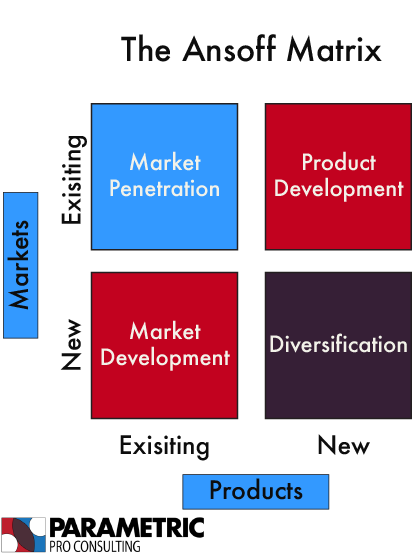In order to run a successful business, you must always be thinking long term. Successful business people know not to settle, and always seek ways to grow profits and attract new customers. We know that there are plenty of ways to do this, for example, by developing new products, or entering new markets, but how do you know which approach is best for your business? This is where we use the Ansoff Matrix.
This Ansoff Matrix was developed in 1957 by mathematician and business manager H. Igor Ansoff and was published in the Harvard Business Review that same year. It is most recognized for giving generations of business leaders a simple and efficient way to think about the risks of growth.
The model is categorized into four quadrants: market penetration, market development, product development, and diversification.

Market Penetration
Trying to grow in existing markets, with the same products.
Ex. A car manufacturer that continues to make the same cars and sell them to the same market segment. For them to increase sales, maybe they are looking at ways to improve their marketing.
The company is trying to increase their market share, drive out competitors, and take its competitors' customers to increase sales and grow its company.
This is considered a low-risk strategy because they already have strong knowledge of both the market, their customers and their products. On the flip side, however, this also means that there is less potential for big rewards.
In this instance, competition is likely quite intense, so to keep growing and stand out from the competitors, a strong unique selling point would be necessary.
Product Development
Expanding in the same markets by selling new products.
Ex. A car manufacturer brings in new and improved models of a car, introducing new features like heated seats, a better sound system etc.
The company is trying to get an advantage over competitors by designing and introducing new and innovative products compared to what is currently on the market.
This is a step up in risk compared to market penetration. The additional research and development expenses generate a high level of cost involved with constantly putting out new products and new models. There is never a guarantee that the new product they put out will be successful. The extensive research they already have on the market, however, makes this strategy medium risk.
Market Development
Expanding into new markets but continuing to sell the same products into those markets, through expanding to international markets, or repositioning.
Ex. This could look like a UK car manufacturer that starts selling cars in Canada and Europe. Or repositioning, trying to access and sell to different customer segments, repositioning the brand to appeal to other market segments that you weren’t appealing to before.
The risk for market development is at the same level as it is for product development. Because most businesses know their target market quite well, entering new markets will present unknown challenges. Despite the risk, there are several big growth opportunities, because they are continuing to sell the same products that they have a deep knowledge of.
Diversification
Expanding into completely new markets with completely new products.
Ex. A car manufacturer decides to start making and selling mobile phones.
Diversification is the highest risk strategy of them all because the company would have no background knowledge of these products and markets. This means you need to rebuild the customer trust that you serve in this new market, just as well as in the current market that the company is operating in.
Despite having the highest risk, diversification also offers the highest potential rewards. Although the level of risk is higher in the short term, it can help shield the business from risks over the long term. This is because if the demand for one of the markets collapses, the company still has a range of different products to sell in other markets.
Conclusion
This matrix can be a really powerful tool in guiding strategic direction, it can particularly help a business when it’s making these decisions, which relate to how they’re going to increase profits and grow. As you go further down and to the right of the matrix, risk tends to increase, so market penetration carries the least amount of risk, and diversification has the greatest risk. But the greater the level of risk, the greater potential there is for rewards.
If this article was helpful to you, please consider sharing it with your network!
For more useful information, check out our other Insights!
Are you interested in the consulting industry? Parametric Pro Consulting Foundations offers more in-depth knowledge on this article as well as several other topics to prepare you for a career in business and consulting. Check it out here!
